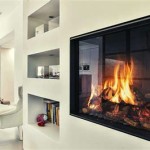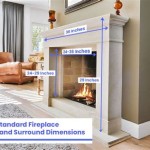Best Colors to Paint a Fireplace: A Comprehensive Guide
The fireplace, often the focal point of a living room or family area, provides warmth and visual interest. Selecting the right color to paint a fireplace can significantly impact the overall aesthetic of a space, complementing existing décor and defining the room's atmosphere. This article explores a range of color options suitable for fireplace painting, discussing their individual characteristics, ideal applications, and potential considerations.
Understanding the Influence of Color Psychology
Color psychology, the study of how colors affect human behavior and emotions, plays a crucial role in interior design. By understanding the psychological impact of different colors, individuals can make informed decisions about fireplace paint choices that align with their desired ambiance. For instance, warm colors like reds and oranges evoke feelings of energy and excitement, while cool colors like blues and greens create a sense of calmness and serenity. Neutral colors, such as grays and whites, offer versatility and can be used to create a sense of sophistication or minimalist elegance.
The existing color palette of the room, the amount of natural light, and the architectural style of the fireplace all contribute to the ultimate effect of the chosen paint color. A small room with limited natural light may benefit from lighter paint colors that reflect light and create a sense of spaciousness. Conversely, a large, well-lit room can accommodate bolder, darker colors that add drama and depth.
Exploring Common Fireplace Paint Color Options
Numerous paint color options are available for fireplaces, each offering a unique aesthetic and suitability for diverse interior styles. This section explores some of the most common and effective choices.
White: White is a classic and versatile choice for fireplace painting. It offers a clean, crisp look that brightens the room and complements a wide range of décor styles. White fireplaces are particularly effective in modern and minimalist spaces, where they contribute to a sense of simplicity and elegance. Different shades of white, such as off-white, cream, and ivory, can introduce subtle variations in tone and warmth.
The neutrality of white allows it to blend seamlessly with surrounding walls and furnishings, providing a blank canvas for decorative accents. It is also effective at creating a sense of spaciousness in smaller rooms. However, white can be prone to showing dirt and soot, requiring regular cleaning and maintenance.
Gray: Gray provides a sophisticated and contemporary alternative to white. It offers a neutral backdrop that works well with both warm and cool color schemes. Lighter shades of gray can create a soft and airy feel, while darker shades add depth and drama. Gray fireplaces are particularly well-suited for modern, transitional, and even rustic interiors.
Gray also provides excellent contrast when paired with white or cream-colored walls. It can also complement stainless-steel accents and natural wood tones. The versatility of gray extends to its ability to conceal dirt and grime more effectively than white, making it a practical choice for high-use fireplaces.
Black: A black fireplace makes a bold and dramatic statement. It adds a touch of sophistication and elegance to any space. Black fireplaces work exceptionally well in modern, industrial, and art deco interiors. They can create a striking contrast against lighter walls and furnishings, adding depth and visual interest to the room.
While black can be a powerful design choice, it is important to consider the size and lighting of the room. Black can make a small room feel even smaller, and it may absorb too much light in a poorly lit space. However, in a large, well-lit room, a black fireplace can serve as a stunning focal point.
Beige and Cream: Beige and cream are warm neutral colors that can create a cozy and inviting atmosphere. These colors are particularly well-suited for traditional and farmhouse-style interiors. Beige and cream fireplaces can soften the starkness of white walls and provide a harmonious balance with natural wood tones.
These colors offer a subtle warmth that can make a room feel more comfortable and welcoming. They are also effective at concealing minor imperfections in the fireplace surface. However, beige and cream can sometimes appear dated or bland if not paired with complementary colors and textures.
Blue: Blue fireplaces can create a serene and calming atmosphere. Lighter shades of blue, such as sky blue or powder blue, can evoke a sense of tranquility and openness. Darker shades of blue, such as navy blue or royal blue, can add depth and sophistication. Blue fireplaces work well in coastal, cottage, and eclectic interiors.
Blue is often associated with relaxation and peace, making it a suitable choice for bedrooms or living rooms designed for relaxation. It can also complement natural stone elements in the fireplace design. The use of blue requires careful consideration of the surrounding colors, as it can sometimes clash with warmer tones.
Green: Green fireplaces can bring a touch of nature indoors. Lighter shades of green, such as sage green or mint green, can create a fresh and airy feel. Darker shades of green, such as forest green or emerald green, can add richness and depth. Green fireplaces work well in bohemian, nature-inspired, and traditional interiors.
Green is often associated with growth, renewal, and harmony. It can be a calming and refreshing color choice for a fireplace. Pairing green with natural wood accents and plant life can further enhance the connection to the outdoors. The specific shade of green chosen should complement the existing color palette of the room.
Key Considerations for Choosing Fireplace Paint
Selecting the right color for a fireplace involves more than just aesthetic preferences. Several key factors should be considered to ensure a successful and long-lasting result.
Material of the Fireplace: Different fireplace materials, such as brick, stone, and wood, may require different types of paint and preparation techniques. Brick fireplaces, for example, are porous and may require a primer specifically designed for masonry. Stone fireplaces may benefit from a paint that highlights the natural texture of the stone. Wood fireplaces, if painted, should be prepared with a suitable primer to prevent the paint from peeling or cracking.
Prior to painting, it is crucial to thoroughly clean the fireplace surface to remove any soot, dirt, or grime. This will ensure proper adhesion of the paint and prevent any discoloration. For brick and stone fireplaces, a wire brush can be used to remove loose debris. For wood fireplaces, sanding may be necessary to create a smooth surface.
Type of Paint: The type of paint used on a fireplace should be heat-resistant and durable. Latex paint is a popular choice for its ease of application and cleaning. However, for fireplaces that generate a significant amount of heat, a high-heat paint specifically designed for fireplaces or stoves may be necessary. These paints are formulated to withstand high temperatures without cracking, peeling, or discoloring.
The finish of the paint is also an important consideration. A matte finish can create a soft and understated look, while a glossy finish can add a touch of shine and reflect light. Semi-gloss and satin finishes offer a balance between the two, providing some shine without being overly reflective. The choice of finish should align with the overall style of the room and the desired aesthetic.
Style of the Room: The paint color should complement the existing style and décor of the room. A modern room may benefit from a sleek and minimalist color like white, gray, or black. A traditional room may be better suited for a warmer color like beige, cream, or a muted green. A farmhouse-style room could incorporate distressed finishes or chalk paint for a rustic look.
The color of the fireplace should also harmonize with the surrounding walls, furniture, and accessories. It is important to consider the overall color palette and ensure that the fireplace color complements the other elements in the room. Using color swatches and testing paint samples on a small area of the fireplace can help ensure a satisfactory result.
Practical Tips for Painting a Fireplace
Painting a fireplace is a relatively straightforward DIY project, but following some practical tips can help ensure a professional and long-lasting finish.
Preparation is Key: Thorough preparation is essential for a successful paint job. This includes cleaning the fireplace surface, repairing any cracks or imperfections, and applying a primer. A good primer will help the paint adhere properly and prevent any discoloration or stains from bleeding through.
Protecting the surrounding area is also important. Cover the floor and any nearby furniture with drop cloths to prevent paint splatters. Use painter's tape to mask off any areas that you don't want to paint, such as the mantel or the edges of the fireplace surround.
Application Techniques: Apply the paint in thin, even coats. Avoid applying too much paint at once, as this can lead to drips and runs. Use a high-quality brush or roller for a smooth and consistent finish. Allow each coat of paint to dry completely before applying the next coat.
For brick fireplaces, use a brush to work the paint into the mortar joints. This will ensure that the entire surface is covered evenly. For stone fireplaces, consider using a dry brush technique to highlight the natural texture of the stone. This involves applying a small amount of paint to a dry brush and then lightly brushing it over the surface of the stone.
Safety Precautions: When painting a fireplace, it is important to take necessary safety precautions. Wear gloves and eye protection to protect your skin and eyes from paint. Ensure that the room is well-ventilated to avoid inhaling paint fumes. If using a high-heat paint, follow the manufacturer's instructions carefully and allow ample time for the paint to cure before using the fireplace.
Cleaning up after painting is also crucial. Remove all drop cloths and painter's tape. Dispose of any paint cans or brushes properly. Clean any paint spills or splatters immediately with soap and water. Allow the paint to dry completely before placing any furniture or accessories near the fireplace.

The Top Color Ideas For Painting A Brick Fireplace 700 N Cottage

Our Black Painted Fireplace Bright Green Door

30 Gorgeous Painted Brick Fireplace Ideas

Best Paint Colors For A Painted Fireplace Macfarland Painting

Guide To Fireplace Painting Part 2 Colors And Techniques

Paint Color Picks For Magnificent Mantels Tinted Sherwin Williams

7 Beautiful Ideas For Painting Interior Brick Fireplaces

Guide To Fireplace Painting Part 2 Colors And Techniques
:max_bytes(150000):strip_icc()/208368922_866049550648380_5600741727305574454_n-533ffc956ce04a8eaa7c81d2f7eb1fdd.jpg?strip=all)
30 Gorgeous Painted Fireplace Ideas

How To Paint A Brick Fireplace Beamin Moore
Related Posts








